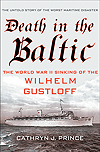
Death in the Baltic: The World War II Sinking of the Wilhelm Gustloff, by Cathryn J. Prince, Palgrave Macmillan, New York, 2013, $27
Evoke the names Titanic or Lusitania, and pitiable images spring to mind of massive loss of life at sea. Encounter the name Wilhelm Gustloff and chances are it will draw a blank. Nevertheless, the torpedoing of the German cruise ship on Jan. 30, 1945, caused history’s greatest loss of life in a single ship sinking. More than 1,500 people died when RMS Titanic sank in 1912, and 1,195 went down with RMS Lusitania in 1915. While no one can be certain how many people actually perished with MV Wilhelm Gustloff, researchers have placed that number at around 9,000, with only 1,200-odd survivors.
The reason for its oversight is readily apparent. Wilhelm Gustloff belonged to Nazi Germany, and it was while the ship was evacuating Germans from what is now Poland, before the advancing Red Army, that a Soviet submarine torpedoed it. The ship’s very namesake was one people preferred to forget after the war, being an early Nazi martyr from Adolf Hitler’s Sturmabteilung, or “Brown Shirts” (the shipbuilders had initially considered naming the ship after Hitler himself). Priority in boarding for that fateful voyage was granted to German government officials, Nazi Party members and military personnel. But the ship also carried thousands of everyday civilian refugees. Intended to provide the Germans with their equivalent of the Dunkirk rescue, Wilhelm Gustloff provided only another propaganda disaster for the crumbling regime. That and postwar German guilt over the war has consigned this tragedy to obscurity.
Launched in 1937, Wilhelm Gustloff was among the first of a class of vessel far more common today than it was the 1930s, designed to provide holiday cruises for the German working classes rather than make high-speed transatlantic runs like its contemporaries SS Bremen and SS Europa. As a large cruise ship, Wilhelm Gustloff was designed for economy of operation rather than for speed, capable of making only about 15 knots. On the night it was torpedoed, Wilhelm Gustloff presented a very large, slow-moving target.
Based on German and Russian records, as well as material gained from interviews with survivors, author Prince has written a gripping account of one of the least-known human disasters of World War II. It relates the story of a Soviet submarine captain of somewhat dubious reputation, employing his own initiative in an effort to avoid impending disciplinary action. It is also the story of a mismanaged and badly overloaded passenger ship that had been pressed into a desperate last-minute evacuation attempt.
—Robert Guttman




